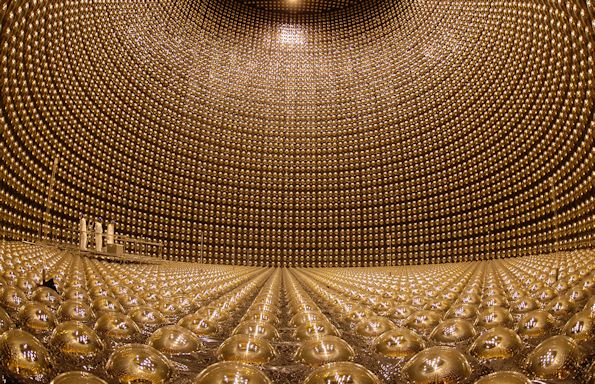
Image: The inside of Super-Kamiokande Credit: T2K
New results from the T2K experiment, which the University is a key partner in, have shown a difference in the way neutrinos and antineutrinos behave – which could help us understand why there is so much matter in the universe, but very little antimatter.
The results of the study of neutrino oscillation suggest there could be a difference, or asymmetry, between the behaviour of matter and antimatter.
Neutrinos are fundamental particles that make up our Universe and are among the least understood. Yet every second around 50 trillion neutrinos from the Sun pass through your body.
Understanding whether neutrinos and antineutrinos behave differently is important, because if all types of matter and antimatter behave the same way, they should have completely wiped each other out shortly after the Big Bang.
To explore the changes in neutrinos, known as oscillations, the T2K experiment fires a beam, which can switch from neutrinos to antineutrinos, from the J-PARC laboratory on the eastern coast of Japan.
When the beam reaches the Super-Kamiokande detector, 295km away, scientists then look for a difference in the oscillations of neutrinos and anti-neutrinos.
The results indicate a high rate of electron neutrino appearances compared to electron ntineutrinos – higher than first expected.
Scientists and engineers from the University are heavily involved in the T2K experiment. They designed and constructed a subsystem of the Near Detector (ECAL) which at 75 tones is the largest detector ever constructed in the West for an experiment in the Far East. They also have responsibilities in running the experiment and analysing the data.
Professor Christos Touramanis, Head of the Liverpool Neutrino group in the University’s Department of Physics, said: “This is very exiting news. T2K was our group’s first major project in this most exciting area of fundamental research.
“We led the construction of the photon detector subsystem and we have been leading science exploitation since 2010 with Dr Neil McCauley and Dr Costas Andreopoulos of the Department of Physics having multiple major roles of responsibility, and a large number of outstanding postgraduate students and PDRAs.
The new result offers tantalising hints that new major discovery is around the corner and will be achieved in our next generation of billion-dolar mega-projects in neutrino oscillations, DUNE in the USA and Hyper-K in Japan, where Liverpool also has very visible leadership.”
Dr Morgan Wascko, international co-spokesperson for the T2K experiment from Imperial College, said: “The current T2K result shows a fascinating hint that there’s an asymmetry between the behaviour of neutrinos and antineutrinos, in other words an asymmetry between the behaviour of matter and antimatter.
“We now need to collect more data to enhance the significance of our observed asymmetry.”
Although this work is promising, there are still systematic uncertainties, so the T2K team is designing an upgrade to the detector to enhance its sensitivities.
T2K is part-funded by the Science and Technology Facilities Council (STFC).